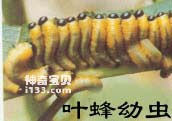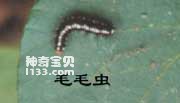Larvae are the stage when insects feed in large quantities. Due to the different sources of their food, their external shapes also vary widely. Some are cute, some are disgusting, and some are terrifying. Here are some common types.

multi-legged larvae
Most of the sawfly larvae of Neuroptera, Euryptera, a few beetles, Mecoptera, Lepidoptera and Hymenoptera are multi-legged larvae. The larvae of the latter three orders are usually also called larvae.

The characteristics of multipod larvae are: in addition to the thorax, the abdomen also has multiple pairs of legs, and the respiratory system is of the perispiral type. According to the body size and leg shape of the larvae, they can be divided into two types: multi-legged type and pod type. The abdomen of the former has several pairs of spines. For example, the mud flies of the order Euryptera have a pair of spines on each of the first 8 abdominal segments, and each of the first 7 abdominal segments also has 1 to 2 pairs of vesicles with respiratory threads; such as the fish flies of the order Neuroptera. , Coleoptera terrapin larvae, etc. The latter, larvae, include most Lepidoptera larvae, sawfly larvae, and some Mesoptera larvae, which are characterized by a cylindrical body and legs on the abdomen.


Walking in a raincoat
The larvae of the moth spin silk and weave them into capsules of various shapes. Broken branches, residual leaves, soil particles, etc. are adhered to the capsules, and the larvae inhabit them. When moving, extend the head and chest and move the bag. The mature larvae hang the sac on the plant with silk and pupate inside the sac. The female moth is wingless and lives in the capsule her entire life. After the male moth emerges, it flies out from the lower end of the sac. After the female moth emerges, it remains in the sac, extending its head and chest, waiting for the male moth to fly in, mate and lay eggs in the sac. Larvae damage fruit trees, forest trees, cereal crops and vegetables.

Legless maggot

The larvae of the order Diptera, the order Hymenoptera, the order Lepidoptera, the order Flea, and the order Coleoptera, etc., all belong to the footless type. The characteristic of apodal larvae is that they do not have any appendages on their bodies, which are mostly caused by the disappearance of the appendages of oligopod or polypod larvae. Since they usually live in an environment where food is easily available, not only are their mobility organs degenerated, but their sensory organs are also underdeveloped. Legless larvae are often divided into three types: full-headed, half-headed, and headless based on the size of their heads.

grub with few legs

Oligopod larvae appear in Coleoptera, Trichoptera and some Neuroptera insects. They have well-developed thoracic legs but no legs on the abdomen. Typical oligopod larvae are predatory, and their locomotor and sensory organs are well developed, but there are also some transitional or specialized types that show varying degrees of degeneration, such as the larvae of scarab beetles - grubs.
nymph
The larvae of insects with incomplete metamorphosis are similar to adults, differing only in size, wings and external genitalia, and are called nymphs. The nymph of the locust is called a locust, which is a representative of insects with incomplete metamorphosis.
animal tags:
We created this article in conjunction with AI technology, then made sure it was fact-checked and edited by a Animals Top editor.